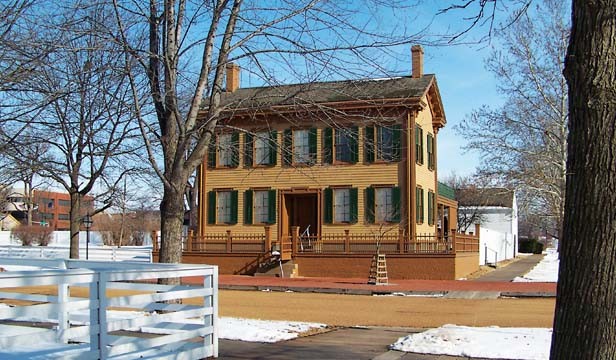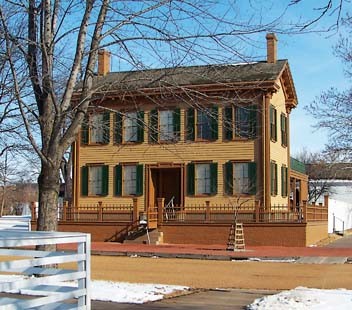
PHOTO BY ERICKA HINE
Lincoln’s home.
When your daughter pauses from her texting to ask, “Mommy, what did Voltaire mean when he wrote that the perfect is the enemy of the good?” – she might – simply drive her down to Eighth and Jackson and let her see for herself.
The National Park Service is preparing a new General Management Plan to guide the NPS administration of the Lincoln Home National Historic Site for the coming 15 to 20 years. The agency, states the most recent draft, “would rehabilitate the neighborhood’s historic landscape to provide visitors with an understanding of and appreciation for the size, density and diversity of this mid-19th century Springfield neighborhood.”
So far so good. The text then explains that, the budget gods willing, the agency would erect new buildings to house a staging area for visitors and spaces for exhibits and visitors services. The new buildings would stand on three now-empty lots at the intersection of Eighth Street and Jackson Street where once stood Lincoln-era houses long ago lost.
So far, not so good at all. “Such contemporary buildings would reflect the historic character of the neighborhood,” said the draft, “with an overall design that visitors would recognize as nonhistoric.” How exactly new and intentionally nonhistoric buildings might reflect the historic character of the 1858 Eighth Street is not explained, although giving the draft a second reading – and its authors the benefit of several doubts – suggests what is meant. Since these lots had buildings on them in 1858 and today do not, putting even ersatz new structures on them will reflect the historic character of the neighborhood.
I guess. When the NPS took over these blocks of Eighth and Jackson streets in 1971, it ruthlessly cleared them of any structures that had not been standing when the Lincolns lived there. The resulting grassy lots surrounded by wood fencing look like pastures or paddocks that suggest a country village more than the industrializing state capital that Lincoln knew.
The agency’s preferred plan would seem to fix that mistake. The agency plans to resort to ersatz constructions because the NPS lacks sufficient documentation to faithfully reproduce the buildings that stood on those lots in the 1850s. This insistence that the neighbors’ houses be not only faithful to the period but faithful to the originals is inconsistent with their setting, but all too consistent with the muddled historicity characteristic of the NPS’s stewardship of the site. As I noted in this paper in 1990 (“Ghost houses,” Nov. 21, 1990), that stretch of Eighth Street resembles an 1850s residential block as much as White Oaks’ center court resembles a city square. While surviving period structures were restored to museum curatorial standards, the pavements, the plants, the sidewalks, the ambience is nowhere near authentic. That includes even the period structures, which look they came from an HO model railroad set, being too perfectly painted and their grounds too perfectly maintained.
For visitors to experience the street as the Lincolns did, they would need to see peeling paint on the barns, unmowed grass and horse crap on the ground, the reek of coal smoke and outhouses in the air. As I suggested 20 years ago, better if Eighth Street were dug up and left as dirt; NPS guides would have to nag visitors to scrape their boots before they come inside, as Lincoln and the kids no doubt were reminded by his wife.
In the absence of documents about the missing houses, could not the NPS resort to educated guesses as to their appearance? (Educated guesses about this period are by now very educated indeed.) Does giving the gawkers “an understanding of and appreciation for the size, density, and diversity of this mid-19th century Springfield neighborhood” really require museum-quality reproductions? The NPS seems not to think so; the aim is that new construction, recall, is merely to “reflect the historic character of the neighborhood,” not to duplicate it.
Instead of ersatz modern buildings tarted up to look like 19th century houses, why not reconstruct on or move to these sites a few of the many Springfield houses of the period which Lincoln knew and for which documentation does exist? The new old houses would be faithful to the period and faithful to the larger setting, which is Lincoln’s Springfield.
But not, perhaps, faithful to NPS’s larger ambition of the plan. The focus of the new structures, and of a proposed expansion of the boundary, is to expand, modernize and consolidate NPS infrastructure on the site to make it easier to run. For all the blather in the draft plan about enhancing the public’s experience of the Lincoln home site, the proposed changes seem intended to enhance the NPS experience at the home site. This may be good enough for the NPS, but it is not good enough for the nation, or for Mr. Lincoln.
